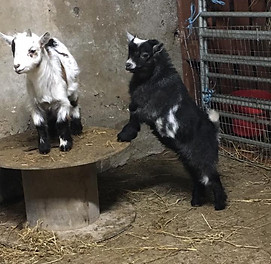
Some information below has been taken from Pat Mercers article on Pygmy Goat keeping on the Pocket Farm website found here
Space Requirements
Pygmy goats being smaller do not require as much space as their larger dairy relatives.
Ideally they should have access to grass although they dont graze they will nibble at it now and again.
An area of hardstanding such as concrete or paving slabs is also recommended as they dont like mud /getting their feet wet.
You should provide them with as much space as you can, if possible its also ideal to rotate 'pastures' when keeping a herd to manage parasites easier and let the ground rest.
If keeping a small number as pets in a smaller area it may be worth while considering a total hard standing space.

Outdoors Housing
If pasture is not adjacent to the goats’ permanent accommodation, then a field shelter needs to be provided. A goat’s coat, unlike that of sheep, is not waterproof and does not contain lanolin. In any case, goats hate the rain and will readily seek shelter at the slightest drop of moisture. It will need to be an appropriate size for the number of goats and it would also be wise to consider including multiple entrances, as some goats are quite bossy and may try to prevent members lower down in the pecking order from entering.



Indoor Housing
If a large outbuilding is available, then think carefully about how to divide it. Hurdles are excellent for this, especially if you wish to try out different options initially. It may well be worth trying out a variety of pen sizes for a family of goats or for individuals.
Ensure there is adequate ventilation throughout, a stable door type arrangement with a top that can be partially closed using a cabin hook when necessary would be my recommendation. Cross-ventilation is important and, to this end, there should be small window/s at the back of the building capable of being opened to provide adequate air flow.


Toys
Even older goats love to have play areas on which to lie down, jump about and run along. There can never be too much provided. They tend to develop the tendency to escape only if they are bored, if they are constantly bullied or if fencing is inadequate. Play facilities need not be elaborate: a couple of solid faced pallets placed and secured together with planks inclined against them would amuse them for hours



Bedding
Hayracks & Buckets
Fencing
Straw is the most commonly used bedding, probably because it is the cheapest. It certainly looks very inviting when first put down, but has to be laid fairly deeply if it is to provide sufficient warmth for the animals, especially during the winter months. It is not particularly absorbent and can become somewhat smelly if not frequently changed, or if the wet spots are not removed and replaced daily. It is very often used as a deep litter system.
Wood shavings can be used used either as a stand alone alternative or a lining for straw. Shavings are certainly more absorbent than straw but need to be topped up fairly frequently as they bed down quite quickly. If used during kidding, a layer of straw over them is required, otherwise ‘breaded kids’ will be the order of the day.
Hayracks should always have lids. Many a kid has been known to jump up into the rack and to break a leg on jumping out, so do not take the risk. They need to be placed so that young stock can have access to the bottom of them but at a comfortable height for the adults. Moveable racks can be placed outside on dry days and are most useful in this regard. They are also good for moving around if hurdles are used for separation of stock. Hayracks with small mesh will cut down on hay wastage.
Water buckets are best placed in a support ring, well off the ground especially when kids are very young. Water for the kids to drink should be placed in small bowls.
Whatever land is available, the periphery has to be properly fenced. This is of the utmost importance. No barbed wire should be included anywhere. Stock fencing is most commonly adopted, together with post and rail. The wire should be properly tightened with no gaps left at ground level. Loose fencing will very soon be lifted and crawled under, especially by kids. It should include a wooden rail above the stock wire. The disadvantage of this type of fencing is that young horned stock, especially, can occasionally get their horns caught. Chain link fencing is another option but is expensive. Strong, weld mesh fencing together with post and rail is probably the best option overall. What ever is decided upon, it has to be tight with no gaps at ground level.



